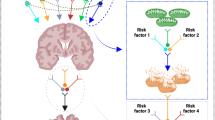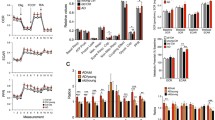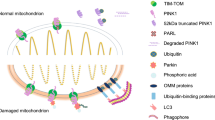Abstract
Empirical evidence indicates that impaired mitochondrial energy metabolism is the defining characteristic of almost all cases of Alzheimer’s disease (AD). Evidence is reviewed supporting the general hypothesis that the up-regulation of OxPhos activity, a metabolic response to mitochondrial dysregulation, drives the cascade of events leading to AD. This mode of metabolic alteration, called the Inverse Warburg effect, is postulated as an essential compensatory mechanism of energy production to maintain the viability of impaired neuronal cells. This article appeals to the inverse comorbidity of cancer and AD to show that the amyloid hypothesis, a genetic and neuron-centric model of the origin of sporadic forms of AD, is not consistent with epidemiological data concerning the age-incidence rates of AD. A view of Alzheimer’s as a metabolic disease—a condition consistent with mitochondrial dysregulation and the Inverse Warburg effect, will entail a radically new approach to diagnostic and therapeutic strategies.




Similar content being viewed by others
References
Cornwell GG, Westermark P (1980) Senile amyloidosis: a protean manifestation of the aging process. J Clin Pathol 33(12):1146–1152
Demetrius LA (2004) Caloric restriction, metabolic rate, and entropy. J Gerontol 59(9):B902–B915
Demetrius LA, Simon DK (2012) An Inverse-Warburg effect and the origin of Alzheimer’s disease. Biogerontology 13(6):583–594
Demetrius LA, Simon DK (2013) The inverse association of cancer and Alzheimer’s: a bioenergetic mechanism. J R Soc Interface, 10(82):20130006
Driver JA, Beiser A, Rhoda A, Kreger BE, Splansky GL, Kurth T, Kiel DP, Lu KP, Seshadri S, Wolf PA (2012) Inverse association between cancer and Alzheimers disease: results from the Framingham Heart Study. BMJ, 344:e1442
Fratiglioni L, De Ronchi D, Agüero-Torres H (1999) Worldwide prevalence and incidence of dementia. Drugs Aging 15(5):365–75
Hardy J (2009) The amyloid hypothesis for Alzheimer’s disease: a critical reappraisal. J Neurochem 110:1129–1134
Hardy J, Selkoe DJ (2002) The amyloid hypothesis of Alzheimer’s disease: progress and problems on the road to therapeutics. Science 297(5580):353–356
Hendrie HC (1998) Epidemiology of dementia and Alzheimer’s disease. Am J Geriatr Psychiatr 6:S3–18
Kruman H (2004) Why do neurons enter the cell cycle? Cell Cycle 3(6):769–73
Nagy Z, Esiri MM, Cato AM, Smith AD (1997) Cell cycle markers in the hippocampus in Alzheimer’s disease. Acta Neuropathol 94(1):6–15
Nunomura A, Perry G, Aliev G, Hirai K, Takeda A, Balraj EK, Jones PK, Ghanbari H, Wataya T, Shimohama S, Chiba S, Atwood CS, Petersen RB, Smith MA (2001) Oxidative damage is the earliest event in Alzheimer disease. J Neuropathol Exp Neurol 60(8):759–67
Palmer AM (2011) Neuroprotective therapeutics for Alzheimer’s disease: progress and prospects. Trends Pharm Sci 32(3):141–147
Pellerin L, Magistretti PJ (2004) Neuroenergetics: calling upon astrocytes to satisfy hungry neurons. Neuroscientist 10(1):53–62
Pimplikar SW (2009) Reassessing the amyloid cascade hypothesis of Alzheimer’s disease. Int J Biochem Cell Biol 41(6):1261–1268
Plun-Favreau H, Lewis PA, Hardy J, Martins LM, Wood NW (2010) Cancer and neurodegeneration: between the devil and the deep blue sea. PLoS Genet 6(12):e1001257
Reddy PH (2004) Gene expression profiles of transcripts in amyloid precursor protein transgenic mice. Hum Mol Genet 13(12):1225–1240
Roe CM, Fitzpatrick AL, Xiong C, Sieh W, Kuller L, Miller JP, Williams MM, Kopan R, Behrens MI, Morris JC (2010) Cancer linked to Alzheimer disease but not vascular dementia. Neurology 74(2):106–112
Selkoe DJ (1991) The molecular pathology of Alzheimer’s disease. Neuron 6(4):487–498
Selkoe DJ (2011) Resolving controversies on the path to Alzheimer’s therapeutics. Nat Med 17(9):1060–5
Seyfried TN, Shelton LM (2010) Cancer as a metabolic disease. Nut Metabol 7(7):7
Shaw RJ (2006) Glucose metabolism and cancer. Curr Opin Cell Biol 18(6):598–608
Swerdlow RH (2007) Is aging part of Alzheimer’s disease, or is Alzheimer’s disease part of aging?. Neurobiol Aging 28(10):1465–1480
Tabarés-Seisdedos R, Rubenstein JL (2013) Inverse cancer comorbidity: a serendipitous opportunity to gain insight into CNS disorders. Nat Rev Neurosci 14(4):293–304
Tanzi RE (2012) The genetics of Alzheimer disease. Cold Spring Harb Perspect Med, 2(10). doi:10.1101/csh2012
Vander Heiden MG, Cantley LC, Thompson CB (2009) Understanding the Warburg effect: the metabolic requirements of cell proliferation. Science 324(5930):1029–33
Warburg O (1931) The metabolism of tumors. Academic Press, New York, RR Smith
Zhu X, Lee HG, Perry G, Smith MA (2007) Alzheimer disease, the two-hit hypothesis: an update. Biochem Biophys Acta 1772(4):494–502
Zhu X, Perry G, Moreira PI, Aliev G, Cash AD, Hirai K, Smith MA (2006) Mitochondrial abnormalities and oxidative imbalance in Alzheimer’s disease. J Alzheimer’s Dis 9:147–153
Acknowledgement
Support from the Max Planck Institute for Molecular Genetics, Berlin, Germany, is gratefully acknowledged.
Conflict of interest
The authors declare that they have no conflict of interest.
Author information
Authors and Affiliations
Corresponding author
Rights and permissions
About this article
Cite this article
Demetrius, L.A., Driver, J. Alzheimer’s as a metabolic disease. Biogerontology 14, 641–649 (2013). https://doi.org/10.1007/s10522-013-9479-7
Received:
Accepted:
Published:
Issue Date:
DOI: https://doi.org/10.1007/s10522-013-9479-7




